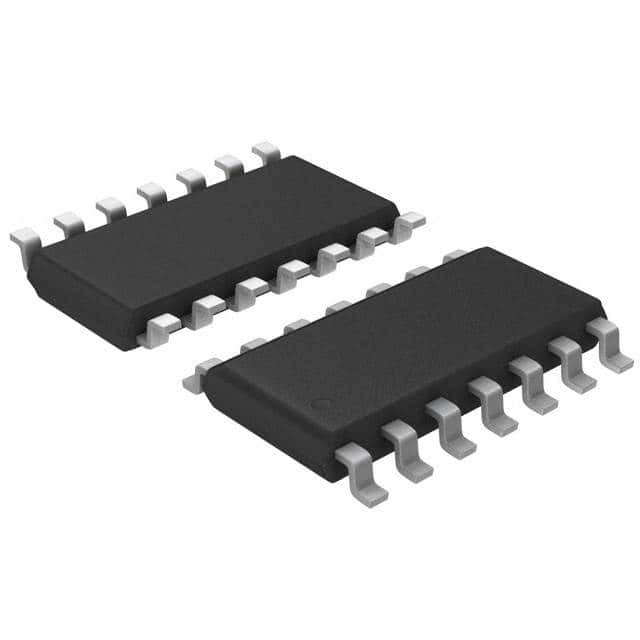CAP1298-1-SL
Product Overview
Category: Integrated Circuit (IC)
Use: Capacitive Touch Sensor Controller
Characteristics: - Low power consumption - High sensitivity - 8 capacitive touch sensor inputs - I2C interface for communication - On-chip LED drivers - Programmable sensitivity and debounce settings
Package: SOP-20
Essence: The CAP1298-1-SL is a capacitive touch sensor controller IC designed for various touch-sensitive applications.
Packaging/Quantity: The CAP1298-1-SL is available in a standard SOP-20 package. It is typically sold in reels of 2500 units.
Specifications
- Supply Voltage: 1.71V to 3.63V
- Operating Temperature Range: -40°C to +85°C
- I2C Bus Interface: Supports Standard, Fast, and High-Speed Modes
- Touch Sensor Inputs: 8 (can be configured as buttons, sliders, or proximity sensors)
- LED Drivers: 8 (sink current up to 25mA per channel)
- Sensitivity Settings: Programmable from 128x to 1x
- Debounce Settings: Programmable from 0ms to 35ms
Detailed Pin Configuration
The CAP1298-1-SL has a total of 20 pins. The pin configuration is as follows:
- IRQ - Interrupt Request Output
- SDA - I2C Serial Data Input/Output
- SCL - I2C Serial Clock Input
- GND - Ground
- VDD - Power Supply Voltage
- LED1 - LED Driver Output 1
- LED2 - LED Driver Output 2
- LED3 - LED Driver Output 3
- LED4 - LED Driver Output 4
- LED5 - LED Driver Output 5
- LED6 - LED Driver Output 6
- LED7 - LED Driver Output 7
- LED8 - LED Driver Output 8
- Y1 - Touch Sensor Input 1
- Y2 - Touch Sensor Input 2
- Y3 - Touch Sensor Input 3
- Y4 - Touch Sensor Input 4
- Y5 - Touch Sensor Input 5
- Y6 - Touch Sensor Input 6
- Y7 - Touch Sensor Input 7
Functional Features
- Capacitive touch sensing: The CAP1298-1-SL utilizes capacitive sensing technology to detect touch inputs on the configured sensor inputs.
- LED control: The IC includes on-chip LED drivers, allowing easy control of LEDs based on touch input events.
- Programmability: Sensitivity and debounce settings can be programmed to optimize the touch sensing performance for different applications.
- Interrupt output: The IRQ pin provides an interrupt signal to the host microcontroller when a touch event is detected.
Advantages and Disadvantages
Advantages: - Low power consumption makes it suitable for battery-powered devices. - High sensitivity enables reliable touch detection even with small capacitance changes. - Flexible configuration options allow customization for various touch-sensitive applications. - I2C interface simplifies communication with the host microcontroller.
Disadvantages: - Limited number of touch sensor inputs (8) may not be sufficient for complex applications requiring more inputs. - Lack of built-in noise filtering may require additional external components in noisy environments.
Working Principles
The CAP1298-1-SL operates based on the principle of capacitive sensing. When a conductive object, such as a finger, approaches or touches the configured touch sensor inputs, it causes a change in the capacitance of the sensor. The IC detects these capacitance changes and generates corresponding touch events.
The sensitivity and debounce settings can be adjusted to optimize the touch detection performance. The IC communicates with the host microcontroller via the I2C interface, providing touch event information and control over the LED drivers.
Detailed Application Field Plans
The CAP1298-1-SL is widely used in various applications that require touch-sensitive controls. Some of the common application fields include:
Consumer Electronics:
- Smartphones and tablets
- Remote controls
- Gaming consoles
Home Automation:
- Touch switches and dimmers
- Thermostats
- Security systems
Automotive:
- Touchscreen infotainment systems
- Steering wheel controls
- Climate control panels
Industrial Controls:
- Human-machine interfaces (HMIs)
- Control panels for machinery
- Touch-enabled industrial displays
Detailed and Complete Alternative Models
- CAP1188-1-BL: Similar to CAP1298-1-SL but with 8 touch sensor inputs and 8 LED drivers.
- CAP
Lista 10 Vanliga frågor och svar relaterade till tillämpningen av CAP1298-1-SL i tekniska lösningar
Sure! Here are 10 common questions and answers related to the application of CAP1298-1-SL in technical solutions:
Q1: What is CAP1298-1-SL? A1: CAP1298-1-SL is a capacitive touch sensor controller IC that can be used to add touch sensing capabilities to various technical solutions.
Q2: How does CAP1298-1-SL work? A2: CAP1298-1-SL works by detecting changes in capacitance when a conductive object, such as a finger, comes into proximity with a touchpad or electrode.
Q3: What are the key features of CAP1298-1-SL? A3: Some key features of CAP1298-1-SL include multiple touch inputs, low power consumption, I2C interface, programmable sensitivity, and built-in LED drivers.
Q4: What technical solutions can CAP1298-1-SL be used in? A4: CAP1298-1-SL can be used in a wide range of technical solutions, including consumer electronics, home automation systems, industrial control panels, automotive applications, and more.
Q5: How many touch inputs does CAP1298-1-SL support? A5: CAP1298-1-SL supports up to 8 touch inputs, allowing for multi-touch functionality in applications.
Q6: Can CAP1298-1-SL detect proximity without direct touch? A6: Yes, CAP1298-1-SL has proximity detection capabilities, which means it can sense the presence of a conductive object without direct touch.
Q7: Is CAP1298-1-SL compatible with different touchpad materials? A7: Yes, CAP1298-1-SL is designed to work with various touchpad materials, including glass, plastic, and even flexible substrates.
Q8: Can CAP1298-1-SL be customized for specific application requirements? A8: Yes, CAP1298-1-SL offers programmable sensitivity and various configuration options, allowing it to be tailored to specific application requirements.
Q9: What is the power consumption of CAP1298-1-SL? A9: CAP1298-1-SL has low power consumption, making it suitable for battery-powered devices or energy-efficient applications.
Q10: Is CAP1298-1-SL easy to integrate into existing designs? A10: Yes, CAP1298-1-SL comes in a compact package and features an I2C interface, making it relatively easy to integrate into existing designs.
Please note that these answers are general and may vary depending on the specific implementation and requirements of the technical solution.


